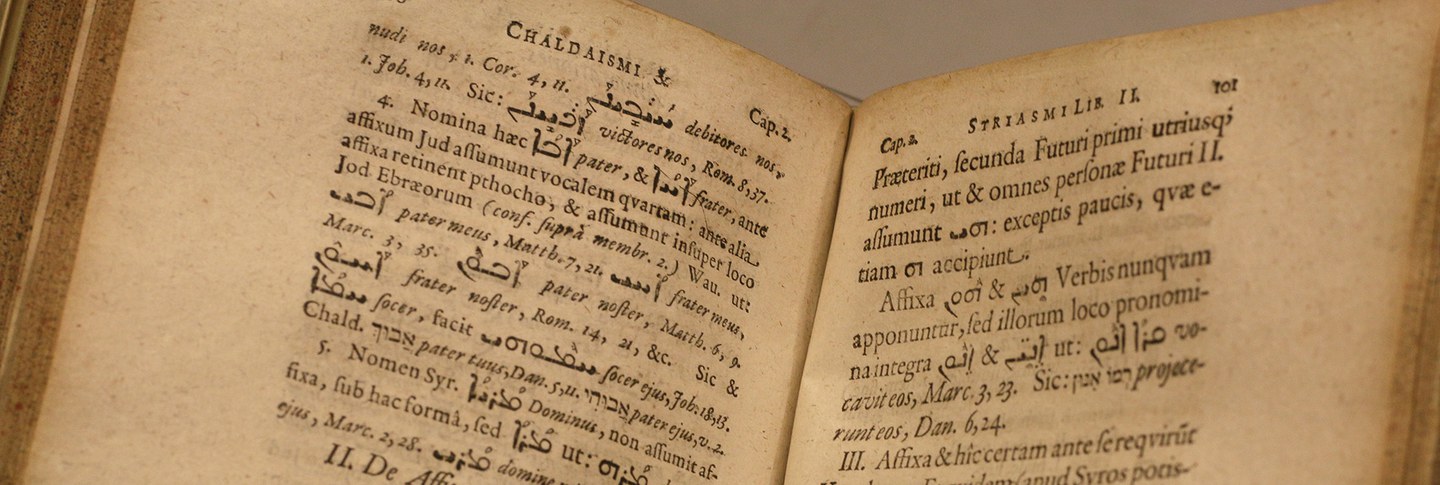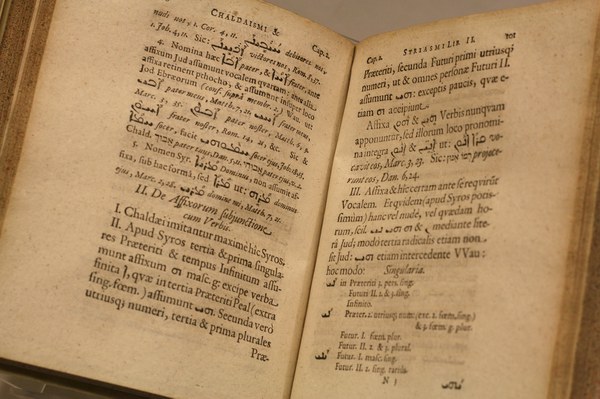Most of the pages are uniform. The Latin text unfolds in a carefully sculpted type, serifs jutting or drooping from the aged ink. On certain pages, though, a sudden order breaks out: charts align the flowing forms of various languages, and the text transcends, for a moment, its didactic purpose.
Dumbarton Oaks is pleased to announce the acquisition of a compendium of pioneering works on Semitic languages penned, primarily, by the seventeenth-century librarian, theologian, and philologist Andreas Sennert. The book, which contains four philological studies by Sennert and one by his mentor, Martin Trost, encapsulates a unique scholarly moment: the burgeoning European interest, post-Reformation, in Hebrew and Jewish studies, and the new awareness of the interplay between theology and philology that subsequently arose.
Sennert’s works, bundled together in the acquisition, include the Chaldaismus & Syriasmus of 1651, focusing on Chaldean and Syriac, and the Arabismus, a 1658 study of Arabic. When the Rabbinismus, which concerns itself with the usage of Hebrew in Talmudic commentaries, was published in 1666, the printed sheets from the first editions of Sennert’s two previous studies were rebound with new preliminaries, meaning that the 1666 editions included in the recent acquisition are, in fact, first editions masquerading as later reprintings.
Rounding out the compendium are Martin Trost’s Grammatica Ebraea, first published in 1627, and Sennert’s Schediasmus, a sort of philological salmagundi surveying a wide number of languages, including Samaritan, Persian, Ethiopic, Coptic, and Armenian.
In one sense, the acquisition reflects the passions of an individual. Sennert (1606–1689), the son of a physician, studied at a number of prominent universities, including those at Leipzig, Jena, and Leiden, where, working under the Dutch mathematician Jacob Golius, he first learned the Arabic language. Settling down to a long administrative and academic career at the University of Wittenberg, Sennert continuously advocated for the study of Semitic languages. Driven by a desire to open up the writings of the Arab world to the academic minds of Europe, including philosophers and theologians, Sennert developed a large collection of Arabic and rabbinic literature while serving as university librarian.
At the same time, Sennert’s treatises are indicative of larger trends in European philological studies, including the growing academic interest in Hebrew studies from the fifteenth century on. Within this field, Sennert is often seen as one of the progenitors of the comparative approach to philology—an approach exemplified by the recently acquired volume. And yet, while Sennert is often described as having liberated philological studies from the religious and theological concerns that had hobbled the discipline, his texts bear witness to a curious theoretical disjunction.
“There was actually a debate that came out of the medieval period, and that’s picked up in Sennert, that tried to determine what the first language spoken by humans was—the language of Adam and Eve,” explains John Zaleski, a Tyler fellow at Dumbarton Oaks. “What’s fascinating is to see Sennert’s critical and philological comparisons between these languages—what we would consider a more scientific approach to linguistics—juxtaposed with this section on the Adamic language, which we wouldn’t really consider critical philology at all.”
The volumes also correspond to developments in typography. The elegant arabesques of four of the volume’s works were provided by Hiob Wilhelm Fincelius, whose printing offices stocked Arabic, Syriac, Greek, and Hebrew types—a relative rarity at the time. By the time Sennert’s Schediasmus was printed in 1681 by the university press at Wittenberg, the need for Ethiopic and Samaritan types was being filled by the famed Leipzig typefounder Anton Janson, who had for years been offering a uniquely wide array of oriental types on the open market.
For all that the studies contain, the physical book is surprisingly small. In fact, at first glance, it seems exactly like a modern textbook, with a relatively unadorned cover and spine and pages that, barring the bends of the various scripts, offer instruction in a visually spare layout. Here and there, however, elegant woodcut tailpieces stain the page, along with designs derived from cast fleurons—calling back to an age when the history of language was treated with mystical reverence.

